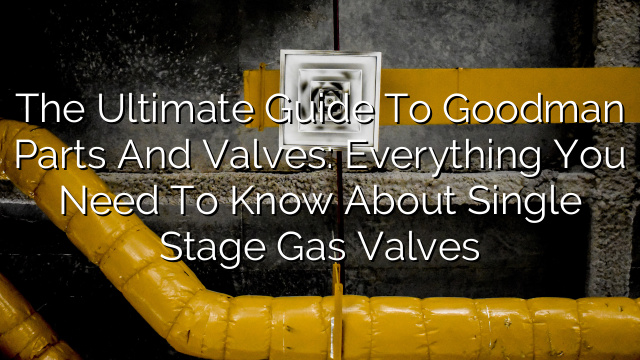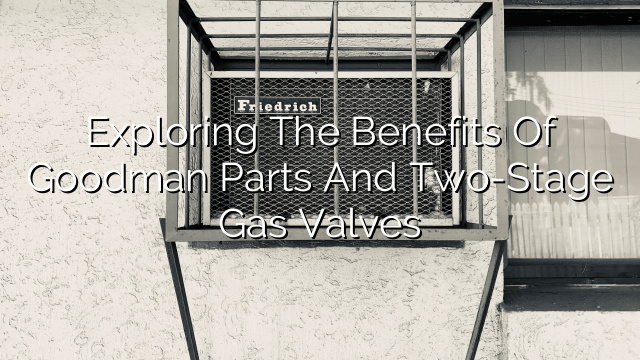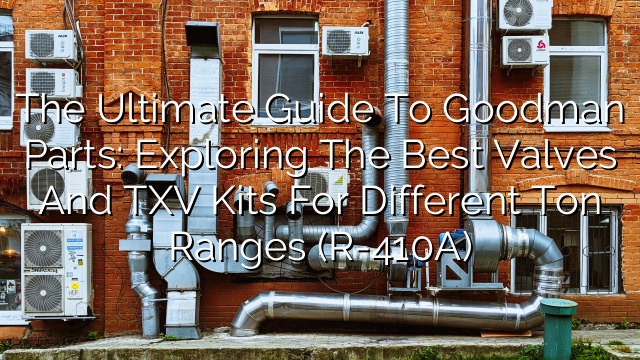Whether you are a homeowner or a professional HVAC technician, understanding the role of Goodman parts and valves in your heating system is essential. Specifically, single stage gas valves play a critical role in the overall operation of your furnace. In this ultimate guide, we will explain everything you need to know about Goodman parts, valves, and single stage gas valves.
What are Goodman Parts?
Goodman parts refer to components specifically designed for use in Goodman heating and cooling systems. These parts are manufactured with precision to meet the highest industry standards, ensuring optimal performance and longevity. Goodman offers a wide range of parts, including valves, motors, circuit boards, sensors, and more.
What are Goodman Valves?
Goodman valves are the components responsible for controlling the flow of gases or liquids within your HVAC system. Valves play a critical role in regulating temperature, pressure, and overall system performance. In the case of single stage gas valves, they control the flow of gas from the main supply line to the burners, determining the heat output of your furnace.
What are Single Stage Gas Valves?
A single stage gas valve is a type of valve that allows gas to flow at a fixed rate to the burners in your furnace. This means that the gas valve is either fully open or fully closed, with no modulation or adjustment. Single stage gas valves are commonly used in older furnaces and are considered more basic compared to two-stage or modulating gas valves.
Advantages of Single Stage Gas Valves
– Simplicity: Single stage gas valves are relatively simple in design and operation, making them easy to maintain and troubleshoot. – Affordability: Compared to two-stage or modulating gas valves, single stage gas valves are generally more affordable, making them a popular choice for budget-conscious homeowners. – Reliable Performance: Single stage gas valves have a long track record of reliable performance, especially in areas with stable climate conditions. – Compatibility: Single stage gas valves are compatible with a wide range of furnaces, making them readily available for replacement or repair purposes.
Common Issues with Single Stage Gas Valves
While single stage gas valves offer simplicity and reliable performance, they are not without their common issues. Some of the most common problems you may encounter include:
– Sticking or Stuck Valves: Over time, single stage gas valves can become stuck due to corrosion or debris buildup, resulting in inconsistent heat output or complete furnace failure. – Faulty Wiring or Connection Issues: Faulty wiring or loose connections can cause the gas valve to malfunction, leading to heating problems or furnace shutdowns. – Wear and Tear: Like any mechanical component, single stage gas valves can wear out over time, especially if they are not properly maintained or lubricated.
When to Replace a Single Stage Gas Valve?
If you are experiencing repeated issues with your furnace’s performance, it may be time to consider replacing the single stage gas valve. Signs that your gas valve may need replacement include:
– Inconsistent heat output or inadequate heating – Furnace not reaching the desired temperature – No heat or complete furnace shutdown – Excessive noise or vibrations during operation – Continuous pilot light issues
How to Replace a Single Stage Gas Valve?
Replacing a single stage gas valve is a complex task that should be done by a qualified HVAC technician. Here is a general overview of the replacement process:
– Shut off the gas supply: Ensure the gas supply to the furnace is completely shut off before beginning any work. – Disconnect electrical connections: Carefully disconnect the electrical connections to the gas valve, noting their placement for reassembly. – Remove the old gas valve: Unscrew or unclamp the old gas valve from the manifold and remove it from the furnace. – Install the new gas valve: Install the new gas valve by reversing the steps taken to remove the old one, ensuring proper alignment and connection. – Test the new gas valve: Restore the gas supply and test the new gas valve for proper operation, making any necessary adjustments.
It’s crucial to consult the manufacturer’s instructions and follow proper safety protocols when replacing a single stage gas valve.
Frequently Asked Questions (FAQs)
- Q: Can I replace the single stage gas valve myself as a homeowner?
- A: It is strongly recommended to hire a qualified HVAC technician to replace the single stage gas valve. Handling gas components can be dangerous without proper training and expertise.
- Q: Are single stage gas valves energy-efficient?
- A: Single stage gas valves are not as energy-efficient as two-stage or modulating gas valves. However, they can still provide reliable heating performance at a lower upfront cost.
- Q: How often should I replace my single stage gas valve?
- A: The lifespan of a single stage gas valve can vary depending on usage and maintenance. It is best to consult with a professional technician to assess the condition of your gas valve and determine if replacement is necessary.
- Q: Can a faulty single stage gas valve be repaired?
- A: In some cases, a faulty single stage gas valve can be repaired by a qualified technician. However, if the valve is severely damaged or has exceeded its lifespan, replacement may be the more cost-effective solution.
- Q: Are Goodman parts and valves interchangeable with other brands?
- A: While Goodman parts and valves are designed for compatibility within Goodman systems, they may not be interchangeable with other brands. It is important to consult with a professional technician or refer to the manufacturer’s guidelines for appropriate replacements.
In conclusion, understanding Goodman parts, valves, and single stage gas valves is crucial for maintaining and optimizing the performance of your heating system. Whether you are a homeowner or a technician, knowing when to replace a single stage gas valve and how to do it safely is essential. By following proper maintenance and repair practices, you can ensure the longevity and efficiency of your heating system for years to come.



